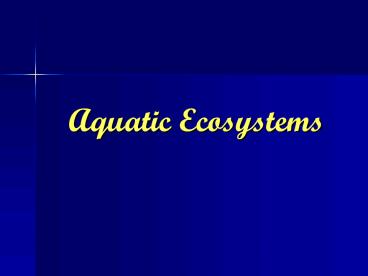Aquatic%20Ecosystems - PowerPoint PPT Presentation
Title:
Aquatic%20Ecosystems
Description:
Aquatic Ecosystems What are the 2 deciding factors that affect land biomes? Would this be the same for aquatic biomes? Salinity Nutrients Freshwater Ecosystems Rivers ... – PowerPoint PPT presentation
Number of Views:116
Avg rating:3.0/5.0
Title: Aquatic%20Ecosystems
1
Aquatic Ecosystems
2
- What are the 2 deciding factors that affect land
biomes? - Would this be the same for aquatic biomes?
- Salinity
- Nutrients
3
Freshwater Ecosystems
- Rivers
- Streams
- Lakes
- Ponds
- Marshes
- Swamps
- Wetlands
4
Flowing Water Rivers and Streams
- Along the river, different populations of
organisms are found due to shading, depth,
temperature, current and energy sources.
5
Watersheds
- describes an area of land that contains a common
set of streams and rivers - drains into a single larger body of water, such
as a larger river, a lake or an ocean
6
Human Impacts
- Dams- change the populations at the site of the
dam as well as downstream from the dam. - Water Pollution- affects downstream populations
- Urbanization
7
Standing Water Lakes and Ponds
- Three Zones
- Littoral Zone- shallow water area, most
productive - Limnetic Zone- Open water beyond literal zone,
less vegetation, includes larger fish - Profundal Zone-bottom, deepest part of the lake.
8
Thermal Stratification
- Dependent on sunlight penetration
- Turnovers mix nutrients
9
Wetlands, Marshes, Swamps
- Wetlands saturated for at least part of a year
and have high organic matter, HIGHEST SPECIES
DIVERSITY, HIGHEST PRODUCTIVITY OF ALL ECOSYSTEMS - Swamps and Marshes permanently saturated,
includes grasslike plants - Provide invaluable ecosystem services replenish
water supply, clean and filter water, stores
floodwater, and provide food and shelter
10
Estuaries A salt and freshwater mix
- Shifting water level
- Changes in salinity
- Organisms uniquely adapted
- Very fertile, high productivity
- Constant influx of nutrients
- Tidal action circulates nutrients
- High level of light pentration
- Large plant mass traps detritus, which fish feed
upon
11
Mangrove forests and salt marshes
- Often seen as worthless, but they provide
valuable services - Salt marshes Habitat, traps pollution and
sediment, groundwater supply, buffers storms - Mangrove forests breeding ground for fish and
crabs, nesting sites for birds, stabilize soils,
storm protection
12
Chesapeake Bay
- Largest, richest estuary in US
- Provides oysters, crabs, fish
- Home to more than 17 million people
- Suffers from pollution from agriculture,
automobiles, homes, industry - Massive campaign to reduce pollution
13
Marine Ecosystems Ocean
- Intertidal Zones
- Biologically productive
- occur on coast
- Stressful conditions
14
(No Transcript)
15
Marine Ecosystems Oceans
- Benthic Environment
- Ocean Floor
- Mostly sediments
- Borrowing organisms worms, clams
- Lots of bacteria
- Abyssal benthic zone and the hadal benthic zone
include life without sun
16
Oceans
17
(No Transcript)
18
Impact of Human Activities on the Oceans
- Development destroys coastal ecosystems
- Pollution from rivers, dumping, spills,
atmospheric pollution - Agricultural runoff
- Increased fishing technologies
19
Coral Reefs
20
Coral Reefs The Underwater Tropical Rain Forest
- Found in warm, shallow sea waters
- Some consist of red coralline algae
- Some consist of colonies of tiny coral animals
and their symbiotic zooxanthellae - Grow slowly, new polyp colonies attach and grow
on old coral. - 3 types fringing reefs, atolls, barrier reefs
21
Coral Reefs
- Fringing Reef
- Submerged platforms of living coral extending
from the shore into the sea - Barrier Reef
- Follow the shore but are separated from it by
water - Great Barrier Reef is worlds largest
- Atoll Ring-shaped islands of coral in open sea
- Form on submerged mud banks or volcano craters
- Surround a seawater lagoon
- Channels connect lagoon to the sea
22
Coral Reefs of the World
23
The Great Barrier Reef
- 1500 species of fish
- 400 different types of coral
- 4,000 mollusks
- 500 species of seaweed
- 215 species of birds
- 16 species of sea snake
- 6 species of sea turtle
- Whales visit during winter
- Worlds largest coral reef
- Over 1257 mileslong
- Off the northeast coast of Australia
- Only grows about one inch per year
24
Human Impacts on Coral Reefs
- 30-50 of coral species rare or endangered in the
tropical western Atlantic - Deforestation? erosion? increased silt ? upsets
balance and inhibits new growth - Diverting fresh water ? increased salinity
- Pollution, building, overpopulation
- Dredging
25
The Everglades
26
The Everglades
- Haven for wildlife
- Sawgrass wetland ecosystem
- Designated national park, International Biosphere
Reserve, World Heritage Site, and a Wetland of
International Importance - Affects the Florida Bay and Keys
- Local economies rely on fisheries and tourism
27
The Everglades
- Human Influence
- Agricultural pollutants- nitrogen and phosphorus-
change plant community - Hoover Dike prevented water from lake Okeechobee
to drain into the everglades - Canals, levees, pump stations divert water to the
Ocean - Urbanization- pollutants and habitat fragmentation
28
The Everglades
- Farmers clean runoff to reduce phosphorus and
nitrogen - Some agricultural land bought and restored to
wetlands - Re-engineer canals, levees, pumps
- Drill into the aquifer and pump excess water into
it in the rainy season































